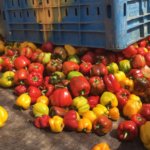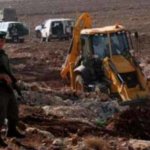Jadaliyya : The Infrastructure of Israeli Settler Colonialism (Part 1): The Jordan Valley
Since its establishment, Israel has distinguished the persons under its civil and military jurisdiction based on religion. Throughout Israel Proper and the Occupied Palestinian Territory (OPT), comprised of the West Bank, including East Jerusalem, and the Gaza Strip, Israel applies a different set of laws to its Jewish and non-Jewish inhabitants respectively. By bifurcating Jewish nationality from Israeli citizenship, the State is able to afford demonstrable and significant privilege to Jewish persons even beyond Israel’s undeclared borders (hence the reference to Israel Proper) at the expense of the political and socio-economic wellbeing of its non-Jewish citizens. Within the OPT, the brunt of Israel’s policies are more severe as they are applied under a military occupation regime for which no oversight or legal redress exists. The impact of these policies is to diminish the number of Palestinians, to remove them from their original lands, and to concentrate them geographically. Within the OPT, they are concentrated into Area A; into no-man’s land within the Seam Zone between the Apartheid Wall and the Green Line; and into isolated communities surrounded by Israeli settlements and their associated military apparatus. Within Israel Proper, they are concentrated in urban townships, in unrecognized villages, and other ghettoized communities.
In this series of videos featuring interviews with Palestinians facing forced displacement, we seek to show a glimpse into Israel’s infrastructure of settler-colonialism.
We start with Part 1, on the Jordan Valley.
The Jordan Valley: Video 1 of 2
The Jordan Valley: Video 2 of 2
Part 1: The Jordan Valley
Israeli policies in the Jordan Valley constitute forced population transfer. The disproportionate distribution of water coupled with systematic demolition of homes aims to drive Palestinian residents to leave their homes. Israeli authorities have settled their civilian population in their place in contravention of Article 49 of the Fourth Geneva Convention.
The Jordan Valley stretches along the eastern front of the West Bank from Ein Gedi in the south to what is known as Tel Maqzooh near Bisan in the north. The area of the Valley constitutes around thirty percent of the West Bank. There are twenty-two Israeli colonial-settlements in the Jordan Valley in which settlers currently live. These colonies control about 22,932 dunums of the Valley’s lands, which they primarily use for agricultural purposes, including, most infamously, for a multi-million dollar palm date industry.


[Confiscated Agricultural Land; and Israeli Settlers/Settlements on the other side of the street]
While originally home to 400,000 Palestinians, Israel’s occupation policies aimed at forcibly displacing the non-Jewish indigenous population, have reduced that number to 56,000 today. These policies have included levying exorbitant taxes on the residents, the outright demolition of Palestinian agricultural and residential structures, and most significantly, the control and mal-distribution of water resources.


[The road to the Friends Meeting House, a local/internationalsolidarity group
working to defend Palestinian rights]
Israel’s control of the water sources has caused several Palestinian wells to dry up. It has also decreased the amount of water that can be produced from other wells and springs. By 2008, Palestinians pumped thirty-one million m3 of water—or forty-four percent less than Palestinians produced in the area prior to the Israeli-Palestinian Interim Agreement of 1995. Due to the water shortage, Palestinians were forced to neglect farmland that had been in cultivation and switch to growing less profitable crops. The World Bank found that the amount of water that was available to residents of the West Bank dropped during this period in comparison to the period prior to the signing of the Oslo peace agreement.

[Water confiscation as a tool of forced displacement.
Infographic from Visualising Palestine. Full description on Jadaliyya, here]
In order to strengthen its hold on the Valley, Israeli occupation authorities have confiscated most of the agricultural lands in the region of Wadi Al Maleh (located parallel to the Jordan River) and transferred it to Military Closed Zones, whose access is denied to Palestinians. For example, Israeli occupation authorities have transformed the eastern part of Wadi Al Maleh into a mine field in addition to transforming the higher ridges to military bases and army firing and training zones. In effect, Palestinian farmers and herders now have access to less than one percent of Wadi al Maleh. The restricted access to water and land has devastated the economic livelihood of Palestinian residents forcing them to leave the Jordan Valley for survival. In 2008 alone, the number of families in the Wadi al Maleh was reduced from 75 to 5.
Short Documentary Below
Interview with activist and teacher, Ibrahim Sawafta. For more information, go to www.JordanValleySolidarity.org
Directed and Edited by Bassam Haddad, Transcribed and Subtitled by Jack Saba, Concept by Bassam Haddad and Noura Erakat, Background Text by Noura Erakat
Article found on Jadaliyya



